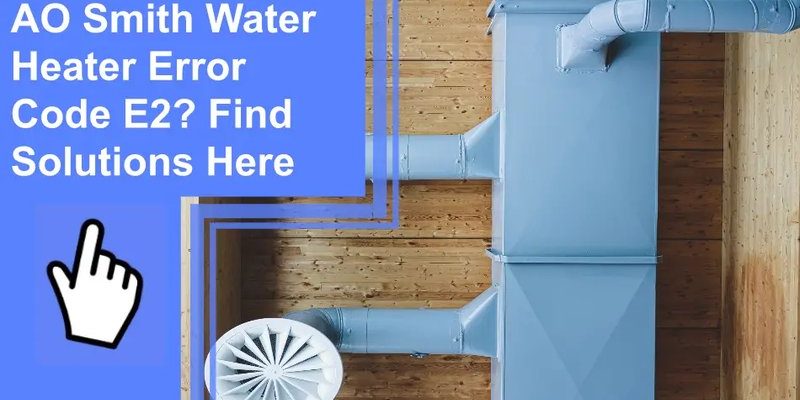
Error codes can feel like a foreign language, but they’re just your water heater’s way of telling you that something needs attention. The E2 error code is a common alert for AO Smith water heaters, indicating a specific issue that usually involves the unit’s temperature sensor. Essentially, it’s like your water heater’s way of saying, “Hey, I’m struggling to measure water temperature accurately!” This can happen for a number of reasons, and it’s key to address these so you can get back to enjoying your hot showers without interruption.
Here’s the deal: an error code doesn’t necessarily mean you have to hit the panic button. Sometimes, it’s just about understanding what your appliance is trying to tell you, and taking the necessary steps to fix it. Let’s dive deeper into what the E2 code means and, more importantly, what you can do about it.
Understanding the AO Smith E2 Error Code
At its core, the E2 error code signals a problem with the temperature sensor of your water heater. Think of the sensor as the water heater’s thermometer. It constantly checks how hot or cold the water is, adjusting the heater’s function to maintain your desired settings. When the sensor isn’t working right, the heater can’t tell if the water is too hot, too cold, or just right. It’s like trying to bake cookies without knowing the temperature of the oven—things are bound to go off course.
The E2 error usually appears when there’s a disruption in the sensor’s ability to read temperature. This can be caused by several factors, such as a faulty sensor, improper wiring, or even a build-up of sediment. Imagine trying to read a thermometer while it’s covered in fog—a bit tricky, right? In the same vein, sediment accumulation can cloud the sensor’s ability to do its job.
Another cause might be electrical issues. If the wiring connecting the sensor to the control board is loose, damaged, or disconnected, it’s like trying to send a text with a broken phone line—you simply won’t get the message across. Understanding these potential causes is the first step towards finding a solution to your error code dilemma.
Common Troubles With Temperature Sensors
Let’s take a closer look at some of the common issues that could lead your AO Smith water heater to flash the E2 error code. A faulty sensor means that the component responsible for reading temperature levels inside the tank isn’t doing its job properly. When this happens, the water heater might behave erratically, turning off unexpectedly or not heating water at all. It’s like trying to drive a car without a speedometer; you won’t know how fast you’re going, and mistakes are bound to happen.
Another issue might be sediment build-up inside the tank. Over time, minerals in hard water can settle and coat the sensor, much like how dust gathers on a shelf. This layer of sediment can insulate the sensor, preventing it from getting an accurate temperature reading. If the sensor “reads” it’s colder than it actually is, the heater might overcompensate by heating the water too much, potentially leading to scalding hot water.
Finally, there are the electrical gremlins. Problems with the wiring, whether due to wear and tear, improper installation, or even pests gnawing away, can disrupt the sensor’s communication with the control board. Without a reliable connection, your water heater isn’t getting the right signals, leading to the flashing E2 code and your water woes.
Steps to Resolve the E2 Error Code
So, you’ve encountered the E2 error and now you’re wondering, “What do I do next?” The good news is, there are several steps you can take to resolve this issue. First, start with a visual inspection. Ensure that the power is off and check the wiring connections to the temperature sensor. Look for signs of wear, frayed wires, or loose connections, which might be the culprits behind the error code.
If everything seems intact, the next step is to tackle the potential sediment issue. Draining your water heater tank and flushing it might alleviate the problem. This process is akin to cleaning out the filter in your coffee machine—it ensures everything flows smoothly and works efficiently. A clean tank can help the sensor get a better read on the temperature, potentially resolving the E2 error.
However, if the problem persists after these checks, it might be time to consider calling in a professional. Replacing the temperature sensor or fixing complex wiring issues often requires a specialist’s touch to avoid further damage. Remember, safety comes first, and having an expert can give you peace of mind that your water heater is back in top working condition.
Preventative Tips for AO Smith Water Heaters
Prevention is often cheaper and easier than repair, so it’s wise to take steps to avoid encountering the E2 error code in the future. Regular maintenance is key. Just like cars need regular oil changes, your water heater benefits from periodic check-ups, which can extend its lifespan and improve efficiency.
Make it a habit to flush your water heater once or twice a year to remove sediment build-up. This simple act can prevent a host of issues, ensuring the sensor remains unobstructed and the water heater operates seamlessly. It might seem like a hassle, but it’s a task that pays dividends in the long run.
Additionally, have a professional inspect your water heater’s electrical components annually. This check-up can catch any issues before they escalate, much like how an annual physical helps keep you healthy. Keeping an eye on the wiring and connections ensures that your water heater continues to function without unexpected interruptions.
In conclusion, while the E2 error code might initially seem daunting, it’s often a problem that can be resolved with a little patience and the right approach. By understanding what the code signifies and taking proactive steps to maintain your water heater, you’re setting yourself up for a more reliable and comforting experience every time you reach for the hot water.
